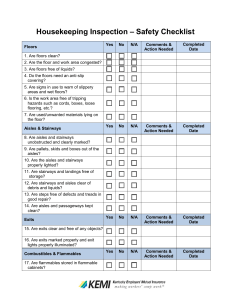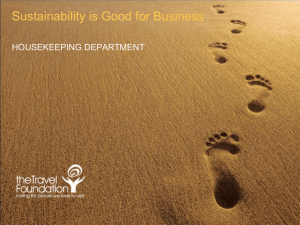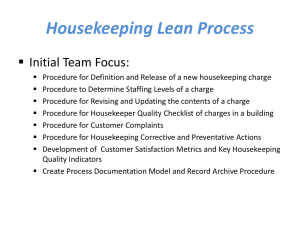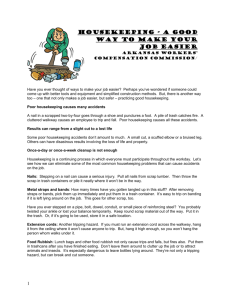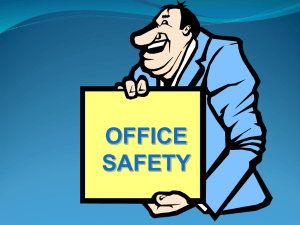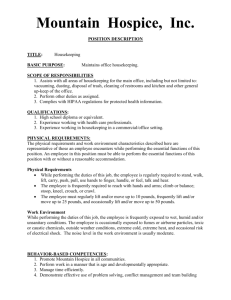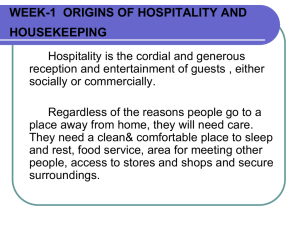EOHS 01-016 Housekeeping Introduction Purpose Definitions
advertisement
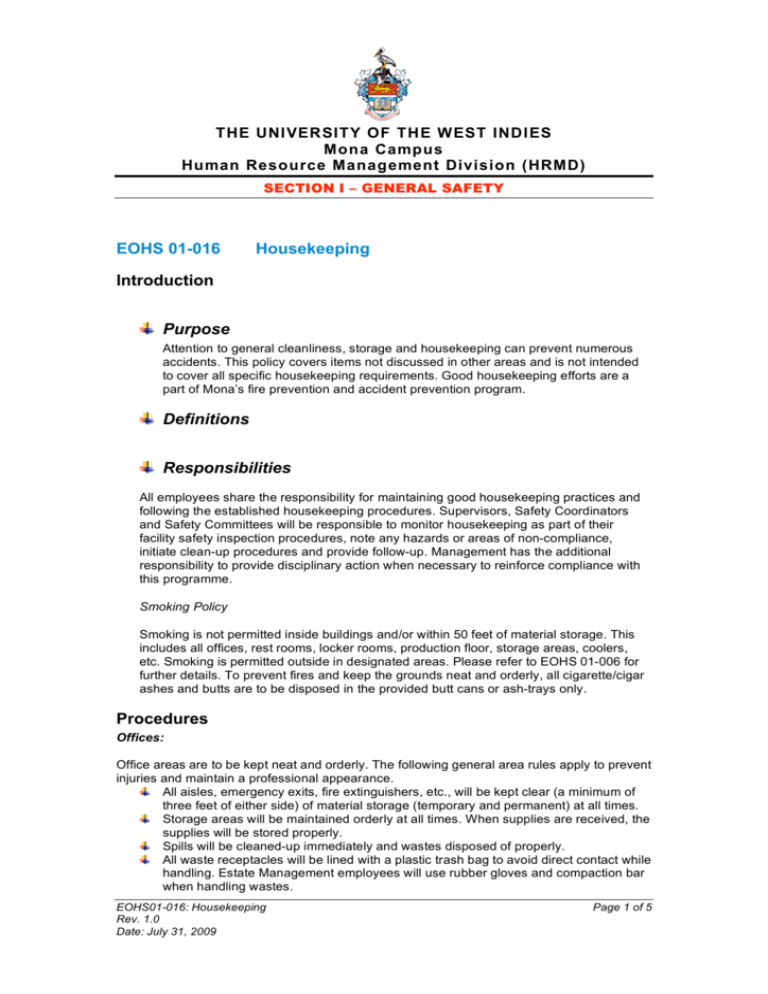
THE UNI VERSITY OF THE WEST INDI ES Mona Campus Human Resource Management Division (HRMD) SECTION I – GENERAL SAFETY EOHS 01-016 Housekeeping Introduction Purpose Attention to general cleanliness, storage and housekeeping can prevent numerous accidents. This policy covers items not discussed in other areas and is not intended to cover all specific housekeeping requirements. Good housekeeping efforts are a part of Mona’s fire prevention and accident prevention program. Definitions Responsibilities All employees share the responsibility for maintaining good housekeeping practices and following the established housekeeping procedures. Supervisors, Safety Coordinators and Safety Committees will be responsible to monitor housekeeping as part of their facility safety inspection procedures, note any hazards or areas of non-compliance, initiate clean-up procedures and provide follow-up. Management has the additional responsibility to provide disciplinary action when necessary to reinforce compliance with this programme. Smoking Policy Smoking is not permitted inside buildings and/or within 50 feet of material storage. This includes all offices, rest rooms, locker rooms, production floor, storage areas, coolers, etc. Smoking is permitted outside in designated areas. Please refer to EOHS 01-006 for further details. To prevent fires and keep the grounds neat and orderly, all cigarette/cigar ashes and butts are to be disposed in the provided butt cans or ash-trays only. Procedures Offices: Office areas are to be kept neat and orderly. The following general area rules apply to prevent injuries and maintain a professional appearance. All aisles, emergency exits, fire extinguishers, etc., will be kept clear (a minimum of three feet of either side) of material storage (temporary and permanent) at all times. Storage areas will be maintained orderly at all times. When supplies are received, the supplies will be stored properly. Spills will be cleaned-up immediately and wastes disposed of properly. All waste receptacles will be lined with a plastic trash bag to avoid direct contact while handling. Estate Management employees will use rubber gloves and compaction bar when handling wastes. EOHS01-016: Housekeeping Rev. 1.0 Date: July 31, 2009 Page 1 of 5 THE UNI VERSITY OF THE WEST INDI ES Mona Campus Human Resource Management Division (HRMD) SECTION I – GENERAL SAFETY Keep file and desk drawers closed when not attended to avoid injuries. Open only one drawer at a time to prevent tipping of file cabinets. At the end of the business day, turn off all office equipment (lamps, coffee-makers, PCs, etc.) and lights to save energy and prevent fires. Production Areas Production areas will be kept neat and orderly, during operations and as follows: All aisles, emergency exits, fire extinguishers, eye wash stations, etc., will be kept clear (a minimum of three feet in front of and to either side) of product storage, material storage, fork trucks and pallet jacks at all times. Spills will be cleaned up immediately. All process leaks will be reported to supervision and maintenance for immediate repair and clean-up. For the most part, Estate Management personnel will be responsible to keep aisles and work floors clear of excessive debris and waste materials during the evening or early morning janitorial routines or when necessary or directed by supervision; however, all employees are responsible to communicate slippery floors to supervision for immediate clean-up. All refuse and waste materials will be placed in the recognized waste containers for disposal. Rest Rooms, Locker Rooms & Break Areas Rest rooms, locker rooms and cafeteria are provided as a convenience for all students, employees, and visitors. The following rules will apply: Employees are expected to clean-up after themselves as a common courtesy to fellow employees. Flammable materials (fire works, explosives, flammable liquids, etc.) may not be stored in lockers or brought on company property. An exception would be the fuel in vehicle tanks and UL/FM listed containers contained in vehicles. All waste receptacles will be lined with a plastic trash bag to avoid direct contact while handling and Estate Management employees will use rubber gloves and compaction bar when handling wastes. All refuse and waste materials will be placed in the recognized waste containers for disposal. Maintenance Areas All aisles, emergency exits, fire extinguishers, etc., will be kept clear (a minimum of three feet of either side) of material storage (temporary and permanent) at all times. Storage Areas will be maintained orderly at all times: Pipe stock stored horizontally on racks and sorted by size Metal stock stored horizontally on racks and sorted by size Sheet metal stock stored vertically in racks and sorted by type All fittings, etc., stored in bins on shelves and sorted by type and use All flammables stored in OSHA-approved Fire Cabinets and self-closing cans where necessary EOHS01-016: Housekeeping Rev. 1.0 Date: July 31, 2009 Page 2 of 5 THE UNI VERSITY OF THE WEST INDI ES Mona Campus Human Resource Management Division (HRMD) SECTION I – GENERAL SAFETY Spills will be cleaned-up immediately by the person responsible and wastes disposed properly. All refuse and waste materials will be placed in the recognized waste containers for disposal. All hazardous waste will be segregated as per EOHS 04-004, Hazardous Material Management. Grounds The grounds surrounding Mona property are an extension of the work place. Grounds that are kept neat and orderly show pride for the facilities and operations and enhance morale for employees, customers and neighbours. The following general rules will apply: All trash will be discarded only in the waste containers provided. Park only in the designated assigned area. Estate Management will be responsible for grounds keeping (mowing, trimming, pruning, planting, etc.) as needed. Material Storage Proper storage procedures are required for dry, raw materials, finished products, flammables/combustibles and compressed gases storage to prevent fires, keep exits and aisles clear and avoid injuries and illnesses. Guidelines for material storage are as follows: General Materials may not be stored any closer than 18 inches from sprinkler heads. Whenever possible, a minimum of 3 feet side clearance will be maintained around doorways and emergency exits. Passageways and aisle will be properly marked or designated. Materials, forklifts, pallet jacks, etc., may not be stored in aisles or passageways. Aisles and passageways will be kept clear of storage and debris. No storage of material is permitted in required exit corridors. For assistance with defining what a required exit corridor is, please contact EOHS. All spills of materials, especially wet spills, will be immediately cleaned-up by the person responsible. All platforms and racks will have maximum load capacity displayed. The weight of stored material will not exceed the rated load capacity. Use of Corridors for Surplus Property Storage and Unauthorized Furnishings All surplus materials and construction debris should be removed promptly from rated corridor systems and should not obstruct nor hinder the egress patterns at any time nor increase the combustible material load within the corridors. Arrangements should be made to pick up old furniture in advance of or concurrent with delivery of new furniture. Do not store surplus material in the corridors. Keep it in the office area until Estate Management can arrange to pick it up. All furniture left or placed in EOHS01-016: Housekeeping Rev. 1.0 Date: July 31, 2009 Page 3 of 5 THE UNI VERSITY OF THE WEST INDI ES Mona Campus Human Resource Management Division (HRMD) SECTION I – GENERAL SAFETY rated corridors without authorization will be considered abandoned. The cost of removing material abandoned in rated corridors will be charged to the responsible departments. Because of the large number of buildings and operations at Mona, the often times difficult task of identifying responsible parties, and the limited staff of support groups, little or no advanced warning may be provided when abandoned property is removed. Departments wishing to recover abandoned property must do so at their own expense. Flammables All flammables will be stored in OSHA-approved flammable storage cabinets or stored outside (at least 50 feet from any structure) Fuels, solvents and other flammables (not stored in original shipping containers) will be stored in OSHA-approved self-closing containers with flame arresters. Flammables may not be stored in open containers (open parts baths, etc.). Flammable storage areas will be kept dry and well ventilated. No storage of combustible materials, open flames or exposed electrical components is permitted in the flammable storage area. Flammable or combustible materials may not be stored in electrical rooms. Electrical rooms must be kept clean and dry at all times. Compressed Gas Gas Cylinder Shipment Receiving • • • • • Inspect bottle for defects & proper marking/labels Ensure stamped date on bottle has not expired Inspect valve assembly and adapter thread area Ensure MSDS is on file or with shipment Follow MSDS requirements for storage Gas Cylinder Storage • • • • • • Cylinder cap securely in place when not in use. Marked with contents and if empty/full. Stored up-right and secured to a stationary structure in an shaded and well ventilated area. Cylinders not stored within 50 feet of exposed electrical components or combustible materials. Cylinders are protected from accidental rupture. Chemically reactive gases not stored within 50 feet of each other. Gas Cylinder Movement • • Must be secured to a cart or cylinder trolley Cap securely fastened • • Gas Cylinder Usage Inspect valve adapter threads. Inspect all fasteners, hoses & regulators prior to hooking up to cylinder. EOHS01-016: Housekeeping Rev. 1.0 Date: July 31, 2009 Page 4 of 5 THE UNI VERSITY OF THE WEST INDI ES Mona Campus Human Resource Management Division (HRMD) SECTION I – GENERAL SAFETY • • • • • Use only for approved purposes. Use in up-right position. Fasten cylinder to structure or cart. Regulators must be of same rated pressure as cylinder. Keep cylinder valve shut when not in use; don't depend on regulators EOHS01-016: Housekeeping Rev. 1.0 Date: July 31, 2009 Page 5 of 5
